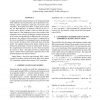Free Online Productivity Tools
i2Speak
i2Symbol
i2OCR
iTex2Img
iWeb2Print
iWeb2Shot
i2Type
iPdf2Split
iPdf2Merge
i2Bopomofo
i2Arabic
i2Style
i2Image
i2PDF
iLatex2Rtf
Sci2ools
ICASSP
2011
IEEE
2011
IEEE
A near-optimal least squares solution to received signal strength difference based geolocation
A simple geometric interpretation for received signal strength (RSS) difference based geolocation can be illustrated by considering a plane containing a single pair of receivers and a transmitter. If the path loss follows a simple inverse power law, the RSS difference (in decibels) between the two receivers can be shown to de ne a circle on which the transmitter must lie. With additional receivers, the position of the transmitter can be solved by nding the common intersection of the circles corresponding to the different pairs of receivers. In practice, the solution of this problem is complicated by the errors contributed by environmental noise, measurement errors and the deviation of the actual path losses from the model. The optimal nonlinear least squares solution can be obtained by performing a search on a planar grid. However, the computational cost becomes an issue when the number of receivers is large. This paper presents an ef cient least squares solution whose performance app...
ICASSP 2011 | Signal Processing | Simple Geometric Interpretation | Squares Solution | Transmitter |
| Added | 21 Aug 2011 |
| Updated | 21 Aug 2011 |
| Type | Journal |
| Year | 2011 |
| Where | ICASSP |
| Authors | Sichun Wang, Robert J. Inkol |
Comments (0)

